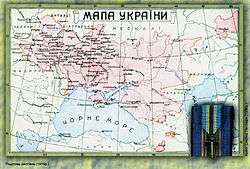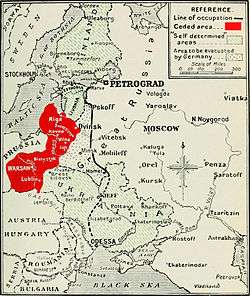Ukraine after the Russian Revolution
Ukrainian territory was fought over by various factions after the Russian Revolution of 1917 and the First World War, which added the collapse of Austria-Hungary to that of the Russian Empire. The crumbling of the empires had a great effect on the Ukrainian nationalist movement and in the short period of four years a number of Ukrainian governments sprung up. This period was characterized by optimism and nation-building, as well as chaos and civil war. It ended in 1921, with the territory of modern-day Ukraine divided between Soviet Ukraine (which would become a constituent republic of the Soviet Union) and Poland, with small regions belonging to Czechoslovakia and Romania.
Alliance and strife

.png)

After the abdication of Tsar Nicholas II, Ukrainian community leaders were able finally to organized the Central Rada in Kiev (Tsentral’na rada), headed by Mykhailo Hrushevsky. They sought an approval of the Russian Provisional Government in Petrograd (St Petersburg) to establish a regional government. The Central Rada consisted of various political parties such as Ukrainian Party of Socialist Revolutionary, Ukrainian Social Democratic Labour Party, Russian Social Democratic Labour Party, Jewish Bund, Polish national party, representatives of Army, peasantry, workers, and others. It quickly gained the support of elements of the Imperial Army in Ukraine. On June 23, 1917, the Central Rada issued its First Universal, declaring Ukrainian autonomy within a Russian federation, which was enthusiastically supported by the First All-Ukrainian Peasant Congress on June 28.
Shortly after the early-November Bolshevik coup in Petrograd and a similar event in Kiev, the Central Rada issued the Third Universal on November 20, 1917, declaring a Ukrainian People's Republic (UNR) in Kiev and condemning the Bolsheviks initiated disorder in Petrograd as politically illegal. Because the legal government in Petrograd was dissolved, the Central Rada had no other choice but to declare its autonomy with its own regional government that was previously approved by the Russian Provisional Government.[lower-alpha 1] The UNR refused to recognize the newly installed Soviet government, which in turn caused a tension within the Central Rada. The Bolshevik government demanded an all-Russian union. The Bolsheviks faction convened an All-Ukrainian Congress of Workers', Soldiers', and Peasants' Soviets in Kiev in December demanding from the Central Rada recognition of Sovnarkom. Finding themselves to be a small minority at the congress of 2,500 delegates, the 100 Bolsheviks and a few others left to join a congress of local deputies in Kharkiv which they renamed the All-Ukrainian Congress of Workers', Soldiers', and Peasants' Soviets. They declared the Bolshevik government of Ukraine (Respublyka Rad Ukrayiny) on December 25, 1917 and claimed that the government of the Ukrainian People's Republic were outlaws.
Upon taking over the government in Petrograd, the Bolsheviks immediately sued for peace with the Central Powers.[1] After more than two months of negotiations, the Bolsheviks led by Joffe[lower-alpha 2] signed the Treaty of Brest-Litovsk, a peace treaty between Russia and the Central Powers, on March 3, 1918.[1][lower-alpha 3][lower-alpha 4] This treaty granted Ukraine independence from Russian control.[1] An independent Ukraine was not a popular notion among Russians.[1] An independent Ukraine coupled with the 1918 Russian great hunger[lower-alpha 5] greatly weakened the leadership of Lenin and the Bolsheviks in Russia.[1] Ukraine continued to gain territory after the treaty was signed because the armies of the Central Powers pushed deeper into Russia, thus freeing more Ukrainians from Russian control especially in the Kuban and in the lands of the Don Cossacks and the Terek Cossacks all of which contained very large Ukrainian populations.[1][2][3] By late spring 1918, Ukraine with support from the Central Powers had gained control of the lower Volga River and began to receive oil shipments from Baku through the Volga ports of Tsaritsyn and Saratov.[4][lower-alpha 6] The Cossacks fiercely abhorred Bolshevism. After the July 6, 1918, assassination in Moscow of the German Ambassador to Russia Count Mirbach, many Bolsheviks who resented the terms of the peace treaty began guerrilla warfare and genocide with very strong support from Felix Dzerzhinsky, the head of the Cheka.[1]
In late 1917 to early 1918, the UNR for couple of months lost Kiev to the Bolsheviks, but the UNR with Central Powers support controlled of much of Ukraine, pushed the Bolsheviks out of Kiev on March 1, 1918, and forced the Bolsheviks to convene their government in Taganrog, Russia, on the coast of the Sea of Azov. The Congress of Free Hubb'andmen on April 29, 1918 (with the great support of Austrian-German occupants), elected tsarist general P.P.Skoropadsky as Hetman of Ukraine. He proclaimed the overthrow of the Central Rada Government thus suspending the UNR and also outlawed the Communist Party in Ukraine. After the socialist Directorate of Ukraine overthrew the Hetman's government[lower-alpha 7] and then reestablished the UNR on November 13–14, 1918, the Bolsheviks forces with support from Moscow renewed their aggression claiming to be led by the government of Ukraine. Ukraine sent a note of protest requesting to cease the hostilities; Sovnarkom first ignored the request and later stated that it has nothing to do with the war in Ukraine. The Ukrainian government declared a war on January 16, 1919. The Bolsheviks amid fluid alliances with various anarchists would eventually defeat the Ukrainian army that was fighting on several fronts simultaneously.
Meanwhile, the Western Ukrainian People's Republic (ZUNR) was declared in Lviv on October 19, 1918. Within the ZUNR were the largest oil reserves in Europe. The ZUNR formally (and largely symbolically) joined the UNR in hope to gain some support in the war against Poland. A UNR delegation sent to Paris could not gain recognition at the Treaty of Versailles at the end of the World War. UNR forces fared poorly during Polish-Soviet War and a late alliance with Poland wasn't enough to secure the republic. After the Polish-Soviet Peace of Riga, Ukrainian territory found itself split among the Ukrainian SSR in the center, Poland in the west, and Crimea, Kuban, and the former Cossacks lands became southern Russia in the east. Carpathian Ruthenia found itself in Czechoslovakia, and Bukovina in Romania. Ukraine was a rump state of its former self.
In December 1922, with Bolsheviks secure in their power over its territory, Soviet Ukraine joined the Russian, Byelorussian, and Transcaucasian republics to form the Union of Soviet Socialist Republics.
Ukrainian governments (1917–1920)
- Central Rada of the Ukrainian People's Republic: March 17, 1917 – April 29, 1918.
- Hetmanate of the Ukrainian State: April 29, 1918 – December 14, 1918.
- Ukrainian National Council of the West Ukrainian People's Republic: October 18, 1918 – January 22, 1919 (de facto independent until July 1919).
- Directorate of the Ukrainian People's Republic: November 14, 1918 – 1920.
Soviet Ukraine
- Ukrainian People's Republic of Soviets: December 25, 1917 – March 1918.
- Second Ukrainian Soviet government: November 20, 1918 – August 1919.
- All-Ukrainian Revolutionary Committee: April 1919 – July 1919.
- Third Ukrainian Soviet government: December 21, 1919 – 1991.
- Galician Revkom: July 8, 1920 – September 21, 1920
See also
Notes
- ↑ In December 1917, the Central Rada issued Ukrainian currency.
- ↑ Trotsky, People's Commissar for Foreign Affairs, appointed Joffe, but Trotsky resigned his post prior to the signing of the Treaty of Brest-Litovsk. Joffe accompanied the signatory team under protest as a consultant. Grigori Yakovlovich Sokolnikov led the signatory team and signed for the Bolsheviks.
- ↑ The Bolsheviks agreed to the terms of the treaty because if they didn't the German led armies of the Central Powers would push into Petrograd and Moscow and remove the Bolsheviks from power: the Bolsheviks only controlled Petrograd and Moscow at the signing of the peace treaty.[1]
- ↑ On March 7, 1918, the Bolsheviks proclaimed Moscow their capital. The Treaty of Brest-Litovsk placed the independent Baltic countries under German suzerainty. The Bolsheviks were concerned that with the Baltics under German suzerainty, the Germans could easily move a German army into the Winter Palace and overthrow the Bolshevik government located in Petrograd. Lenin commented that if the Germans armies were to occupy both Petrograd and Moscow, the Bolsheviks could retreat to the substantial resources of the Ural-Kuznets region.[1]
- ↑ The Central Powers occupation of Ukraine in the spring of 1918 caused a reduction of available foodstuffs in Russia.[1]
- ↑ In the August 27 supplement to the Treaty of Brest-Litovsk, Germany would grant financial credits to the Bolshevik government in Moscow in return for 25% of the oil from Baku. This oil was shipped across the Caspian and up the lower Volga to Ukraine.[4]
- ↑ With the end of World War I in November 1918 and the defeat of the Central Powers, the Austrian-German support of the Hetman's government evaporated.
References
- 1 2 3 4 5 6 7 8 9 10 Felshtinsky, Yuri (October 26, 2010). Lenin and His Comrades: The Bolsheviks Take Over Russia 1917-1924. New York: Enigma Books. ISBN 9781929631957.
- ↑ "Українська Кубань" (in Ukrainian). гайдамака. Retrieved April 11, 2016.
- ↑ Снєгирьов, Дмитро (February 16, 2012). "Самостійна Кубань. 94 роки проголошення незалежності". Українська правда (in Ukrainian). Київ. Retrieved April 11, 2016.
- 1 2 McMeekin, Sean (2010). The Berlin-Baghdad Express: Ottoman Empire and Germany's bid for World Power. Cambridge, Massachusetts: Belknap Press of the Harvard University Press. ISBN 9780674057395.
References
- Magocsi, Paul Robert (1996). A History of Ukraine. Toronto: University of Toronto Press. ISBN 0-8020-0830-5.
- Subtelny, Orest (1988). Ukraine: A History, 1st edition, Toronto: University of Toronto Press. ISBN 0-8020-8390-0.
- Velychenko, Stephen (2010). Statebuilding in Revolutionary Ukraine. A Comparative Study of Governments and Bureaucrats 1917-1922 (Toronto 2012)
- idem, Painting Imperialism and Nationalism Red. The Ukrainian Marxist Critique of Russian Communist Rule in Ukraine (1918-1925) (Toronto, 2015) http://www.utppublishing.com/Painting-Imperialism-and-Nationalism-Red-The-Ukrainian-Marxist-Critique-of-Russian-Communist-Rule-in-Ukraine-1918-1925.html
